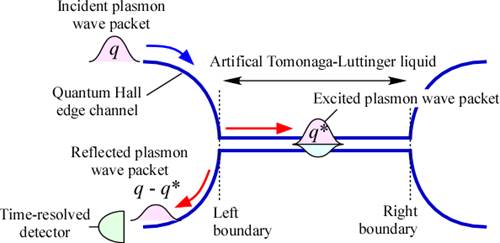Summary
In a world-first, a joint research group including Research Scientist Hiroshi Kamata and Professor Toshimasa Fujisawa, of the Department of Physics at the Tokyo Institute of Technology, and Koji Muraki, Senior Research Fellow at NTT Basic Research Laboratories, has succeeded in observing elementary excitation processes in Tomonaga-Luttinger liquid(1) fromed in a solid-state nanostructure. The result is based on time-resolved measurements(2) of reflected plasmon(3) wave packets from artificial Tomonaga-Luttinger liquid made of multiple quantum Hall edge channels(4).
The observation of the elementary excitation processes in Tomonaga-Luttinger liquid implies the ability of transmitting plasmon signal between one-dimensional plasmon circuits, and thus could be regarded as a groundbreaking work opening up the road to applications in plasmon integrated circuits.
These results were made public in the Advance Online Publication (AOP) of the English scientific journal "Nature Nanotechnology" on the 9th of February at 6:00PM (English time).
Explanation of Technical Terms
1. Tomonaga-Luttinger liquid
In normal conductors motion of electrons with the elementary charge(5) e is important. In one-dimensional conductors, however, collective motion of electrons with an effective charge e* is dominant, and the one-dimensional electronic system with collective motion is called Tomonaga-Luttinger liquid. The theory was constructed in 1950 by Dr. Shinichiro Tomonaga and in 1963 by Dr. Joaquin Mazdak Luttinger, and its existence has been confirmed in a variety of one-dimensional conductors (carbon nanotubes, quantum wires, etc.) However, the elementary excitation processes of collective motion in Tomonaga-Luttinger liquid had not been observed until now, so its fundamental nature couldn't be investigated.
2. Time-resolved measurement
A method of measuring electric charge in plasmon wave packet on quantum Hall edge channels in the time domain. Since plasmons are charge density waves, this was achieved by measuring a time-resolved signal (electric current) proportional to the electric charge in the quantum Hall edge channels.
3. Plasmon
Collective electron motion with spatial modulation of electron density travels as a wave. The field of applied plasmon research is called plasmonics, in keeping with names like electronics and photonics.
4. Quantum Hall edge channels
One-dimensional, unidirectional conductive channels formed along the edge of two-dimensional electron samples in strong electric fields. The direction of electron propagation is determined by the direction of the magnetic field. The absence of backward propagation causes excellent performances verified in various experiments.
5. Elementary charge / effective charge
The electric charge of an electron is called the elementary charge (e*= 1.602×10-19 coulombs). When an electron with the elementary charge e is injected into Tomonaga-Luttinger liquid, only electrical excitation smaller than the elementary charge will be generated. This electric charge e* is called the effective charge, and can be smaller than the elementary charge e. Unique physical phenomena occur in Tomonaga-Luttinger liquid because of the difference between the effective charge and the elementary charge.

Artificial Tomonaga-Luttinger liquid excitation (wave bundle)
Reference
Authors: |
H. Kamata, N. Kumada, M. Hashisaka, K. Muraki, and T. Fujisawa |
Title of original paper: |
Fractionalized Wave Packets from an Artificial Tomonaga-Luttinger Liquid |
Journal: |
Nature Nanotechnology (2014) |
DOI: |
|
. Any information published on this site will be valid in relation to Science Tokyo.



